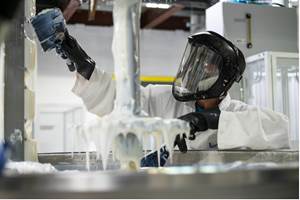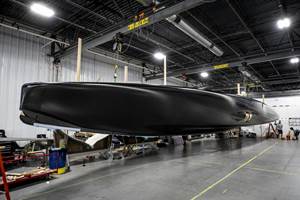An out-of-autoclave progress report
CW Conferences director Scott Stephenson recalls Dale Brosius’ update on Quickstep’s out-of-autoclave work for the F-35 program.
It’s well known that aerospace industry qualification requirements create a high barrier of entry for new resins, fibers, adhesives or manufacturing processes. Aerospace OEMs — commercial aircraft builders, in particular — are forced to establish, early on, the materials and processes that will be used to manufacture a new aircraft. The use of alternatives to qualified materials and processes, although feasible, requires requalification, which can be prohibitively time-consuming and expensive.
Convincing a Boeing or Airbus to requalify a new material or process, then, is not easy, even when the case for the new technology is compelling in terms of saving time and money. One alternative for manufacturers of composite materials and processes is to introduce the technology into the military aerospace market first, where U.S. Department of Defense funding can offset some of the cost of qualification, and then target a larger commercial application.
It was in this regulatory environment that Quickstep (North Coogee, Australia) found itself in 2001, following development of its out-of-autoclave fluid heating technology for the molding of composite structures. Dale Brosius, president of the company’s U.S. subsidiary, Quickstep Composites LLC (Dayton, Ohio), spoke at CompositesWorld’s Carbon Fiber 2010 conference this past December in La Jolla, Calif., and updated the audience on Quickstep’s efforts to move its technology into the production manufacturing environment.
The Quickstep process uses a composite tool that floats on a bladder over a heat transfer fluid. This structure is surrounded by a pressure chamber. Computer control systems and the use of hot and cold heat transfer fluids allows for rapid curing of composite components without an autoclave. The temperatures, dwell times and mold pressures can be customized for individual parts and applications, and the use of heat transfer fluids allows for a rapid transition from one thermal state to another.
Brosius reported primarily on Quickstep’s recent success in landing Small Business Innovation Research (SBIR) development contracts with the U.S. Air Force for the manufacture of composite structures on the F-35 Lightning II. The first, a Phase I contract awarded in 2009 to Quickstep and manufacturing partner Vector Composites Inc. (Dayton, Ohio), was to develop a viable out-of-autoclave cure cycle for Cytec Engineered Materials’ (Tempe, Ariz.) Cycom 5250-4 bismaleimide (BMI) prepreg combined with Hexcel’s (Stamford, Conn.) IM7 carbon fiber using the Quickstep process. The companies evaluated laminate quality and mechanical performance and compared the results to an autoclave baseline. The industrial partner was ITT Integrated Structures (Salt Lake City, Utah).
Brosius said the Phase I work produced 32 panels using 21 unique process combinations, with various bagging schemes, thermal profiles, dwell times, vacuum levels and fluid pressures. He said the best performance was found when the vacuum levels inside the part and above the part were controlled independently. This permitted the extraction of air and void-forming gases, while also providing required compaction at gelation.
The subsequent Phase II contract, awarded to Vector and Quickstep, expands the work to include Cytec’s Cycom 977-3 epoxy structural prepreg, in addition to Cycom 5340-4 BMI. The 27-month effort involves development of a database of mechanical properties relevant to the critical design inputs, including hot/wet conditions; demonstration of manufacturing technology using prototype full-scale structural components that represent the blade seals and stabilizer spars on the current F-35 design; and subsequent destructive or fatigue testing. The effort includes production-capable tooling design and manufacture and demonstration of the intended manufacturing steps. Also on the docket is a cost analysis and comparison of autoclave and Quickstep’s processes, based on actual parts, to build a case for industrialization. Other partners include ITT Integrated Structures (blade seals), London, U.K.-based BAE Systems (spars) and Bethesda, Md.-based Lockheed Martin (F-35 prime contractor).
In summary, Brosius noted that the Quickstep process might allow the use of an existing design allowables database with a relatively modest qualification effort. To date, both the epoxy and BMI resin systems have been successfully cured with significantly shorter cycle times and validated via a preliminary screening matrix. Since the Carbon Fiber conference, Quickstep also announced the commercialization of the Quickstep process equipment (see “Editor's Picks," at right), which makes the process available for licensed purchase by other composites processors.
Related Content
Composite resins price change report
CW’s running summary of resin price change announcements from major material suppliers that serve the composites manufacturing industry.
Read MoreMaterials & Processes: Fabrication methods
There are numerous methods for fabricating composite components. Selection of a method for a particular part, therefore, will depend on the materials, the part design and end-use or application. Here's a guide to selection.
Read MoreScott Bader ATC begins Crestabond MMA structural adhesive production
Scott Bader’s Drummondville, Canada, facility has begun manufacturing and supplying composites-applicable adhesives to its North American customers.
Read MorePro-Set named official materials supplier for New York Yacht Club American Magic
Competitive sailing team prepares for the 37th America’s Cup beginning in August 2024 with adhesives, resins and laminate testing services for its AC75 monohull construction.
Read MoreRead Next
CW’s 2024 Top Shops survey offers new approach to benchmarking
Respondents that complete the survey by April 30, 2024, have the chance to be recognized as an honoree.
Read MoreFrom the CW Archives: The tale of the thermoplastic cryotank
In 2006, guest columnist Bob Hartunian related the story of his efforts two decades prior, while at McDonnell Douglas, to develop a thermoplastic composite crytank for hydrogen storage. He learned a lot of lessons.
Read MoreComposites end markets: Energy (2024)
Composites are used widely in oil/gas, wind and other renewable energy applications. Despite market challenges, growth potential and innovation for composites continue.
Read More















.jpg;maxWidth=300;quality=90)








